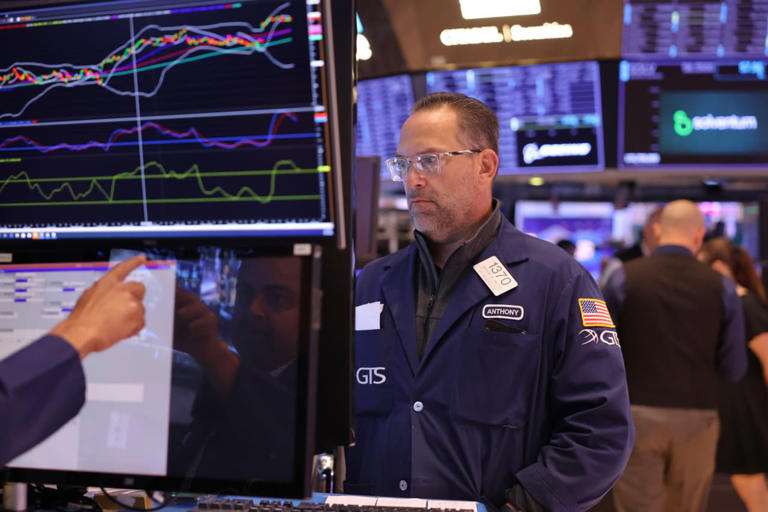The stock market has seen a significant shift in investor behavior over the past six months. Previously, an average investor like Joe would have been content paying $5 for a dollar of the S&P 500’s future profits. However, the current market trend shows that Joe is now willing to pay a much higher price.
According to recent data, investors are now paying 20.57 times the projected profits of each share in the S&P 500 over the next year. This marks a 3.4 point increase in the index’s valuation since its low point in October. It is worth noting that such a rapid surge in the S&P 500’s price-to-earnings multiple is rare, occurring only 5% of the time in the past three decades, as noted by renowned strategist David Rosenberg.
In a healthy market, corporate profits and valuations expectations generally align. However, the estimated earnings per share for the S&P 500 in 2024 is $243.33, which is only slightly higher than projections from early January.
So, why is Joe now willing to pay a much higher price?
This year’s market presents a perplexing situation. Valuations have surpassed historical averages spanning 25 years. Despite the belief of some prominent strategists that these levels are unwarranted, they have still revised their price targets for the S&P 500 upwards. This decision stems from a desire to align with the market’s increasingly bullish sentiment and avoid potential inaccuracies in their predictions.
Morgan Stanley’s Mike Wilson, in a recent note, candidly admitted, “To be honest, our ability to forecast the profits-to-earnings ratio in the past year has been poor. While we firmly believe that valuations are too high, we lack confidence in our ability to accurately predict when or to what extent this normalization will occur.” Nevertheless, Wilson increased his 12-month target to 5,400 points from 4,500.
One explanation for the high valuations is the abundance of liquidity. There is a significant amount of money available for investment in the market, which is contributing to the increase in valuations. Money-market fund balances, which are often seen as a source of cash, reached a record high of $6 trillion in February, and remain above this level as of the week ending May 29.
The idea is that this sidelined money, typically invested in short-term debt like Treasury bills, can be used to purchase stocks at any time, creating a feedback loop. Other indicators of liquidity also suggest a healthy amount of money in the system. For example, the overnight reverse repurchase facility, where institutions deposit excess cash to earn interest from the Federal Reserve, currently holds $440 billion. Additionally, the M2 money supply, which measures the amount of money in the economy, stands at around $21 trillion.
The surge in funds circulating in the market indicates a willingness to take on more risks. The majority of the S&P 500’s increased value can be attributed to investors driving up the prices of technology stocks, which have been buoyed by optimism surrounding artificial intelligence. These technology giants, known as the Magnificent Seven, namely Nvidia, Apple, Amazon.com, Microsoft, Google parent Alphabet, Tesla, and Meta Platforms, are currently trading at a price-to-earnings ratio of 30.71 based on their projected earnings for the next 12 months.
According to Dow Jones Market Data, their combined P/E ratio has risen by 3.8 points since hitting a low in October and is now above their 10-year average. This suggests that a significant portion of the S&P 500’s inflated valuation can be attributed to the performance of the tech sector.
This idea is further supported by the analysis of the S&P 500 Equal-weight index, which assigns equal importance to each stock. As of Friday, the index is trading at a price-to-earnings ratio of 16.31 for the next 12 months. Although the valuation has increased since October, it is in line with the average over the past 10 years, indicating a normalization in the price paid for a variety of companies.
Furthermore, price momentum is likely causing investors to remain in the market for longer than they intended. The continuous rise of the S&P 500, with the index reaching a record level 24 times in the first half of the year, generates a sense of excitement. With few sellers willing to sell, buyers must pay higher prices for each dollar of profit in order to attract a seller.
However, it is important to note that exuberance does not necessarily indicate logical reasoning. According to economist David Rosenberg, the current stock market situation is driven by animal spirits, sentiment, and speculation, rather than economic fundamentals. This sentiment of irrationalism echoes the words of economist Alan Greenspan, who famously used the term “irrational exuberance” in 1996 to describe the behavior of the stock market.
In simpler terms, this implies that equities are currently overvalued. Consequently, there is a risk of a significant decline in stock prices if inflation rises too high or if the profits of major artificial intelligence companies fail to meet expectations.
